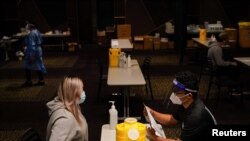ຕໍາຫລວດໄດ້ຖືກສົ່ງໄປທີ່ນະຄອນຊິດນີຫລາຍຂຶ້ນ ຊຶ່ງເປັນຈຸດຮ້ອນແຮງໃນຂະນະທີ່ການລະບາດຂອງໂຄວິດ-19 ສາຍພັນໃໝ່ເດລຕ້າ ຍັງມີກໍລະນີເພີ້ມຂຶ້ນຢ່າງຕໍ່ເນື່ອງ ໃນເມືອງທີ່ໃຫຍ່ທີ່ສຸດຂອງອອສເຕຣເລຍ. ເຈົ້າໜ້າທີ່ທາງການແພດຂອງລັດ ນິວ ເຊົາສ໌ ເວລ ກ່າວວ່າ ການບໍ່ມີລະບຽບເພື່ອໃຫ້ປະຕິບັດຕາມກົດການປິດເມືອງ ໃນເຂດທີ່ມີປະຊາກອນອົບພະຍົບຈໍານວນຫລວງຫລາຍແມ່ນເຮັດໃຫ້ເກີດການແຜ່ລະບາດຢ່າງຮຸນແຮງ. ຟິວ ເມີເຊີມີລາຍງານຈາກນະຄອນ ຊິດນີ, ເຊິ່ງ ທິບສຸດາ ຈະນໍາເອົາລາຍລະອຽດ ມາສະເໜີທ່ານໃນອັນດັບຕໍ່ໄປ.
ຕໍາຫລວດໃນຈຳນວນເພີ້ມຕື່ມ ກຳລັງຖືກສົ່ງອອກໄປ ຕາມເຂດຊານເມືອງທີ່ໄດ້ຮັບຜົນກະທົບ ແຮງທີ່ສຸດຂອງຊິດນີ ໃນຂະນະທີ່ເຈົ້າໜ້າທີ່ກໍ່ແນະນໍາປະຊາຊົນໃຫ້ໄດ້ຮັບການສັກຢາວັກຊີນ. ໂດຍທີ່ສອງເມືອງໃຫຍ່ທີ່ສຸດ ຂອງອອສເຕຣເລຍເຊັ່ນ ຊິດນີ ແລະ ເມລເບິນ ແມ່ນຖືກປິດເມືອງ, ນາຍົກລັດຖະມົນຕີ ສກັອດ ມໍຣິສັນ ກ່າວວ່າ ສະຖານະການແມ່ນຮ້າຍແຮງທີ່ສຸດ. ເຊິ່ງທ່ານ ໄດ້ກ່າວວ່າ:
“ເຮົາຢູ່ໃນການຕໍ່ສູ້ທີ່ຫຍຸ້ງຍາກລໍາບາກ ກັບສາຍພັນເດລຕ້ານີ້.”
ເຈົ້າໜ້າທີ່ອະວຸໂສຄົນນຶ່ງ ຂອງລັດ ນິວ ເຊົາສ໌ ເວລ ເຊິ່ງເປັນລັດທີ່ມີປະຊາ ກອນອາໄສຢູ່ຢ່າງໜາແໜ້ນທີ່ສຸດ ຂອງອອສເຕຣເລຍກ່າວວ່າ ການຂັດຕໍ່ກົດລະບຽບຢູ່ບາງບ່ອນໃນບໍລິເວນຂອງພວກອົບພະຍົບຈໍານວນຫລາຍ ໄດ້ເຮັດໃຫ້ມີການລະບາດທີ່ຮ້າຍແຮງຫລາຍກວ່າເກົ່າ.
ປະມານສາມສ່ວນສີ່ຂອງປະຊາກອນ ທີ່ອາໄສຢູ່ໃນລັດ ນິວ ເຊົາສ໌ ເວລ ມີຜູ້ຕິດເຊື້ອເກືອບ 5,000 ຄົນທີ່ມາຈາກເຂດປົກຄອງທ້ອງຖິ່ນ 9 ເຂດຂອງຊິດນີ ທີ່ຢູ່ທາງພາກຕາເວັນຕົກຂອງເມືອງ, ເຊິ່ງເປັນບ່ອນທີ່ມີຊາວອົບພະຍົບຈໍານວນຫລາຍອາໄສຢູ່ທີ່ນັ້ນ.
ໃນມື້ວັນພຸດຜ່ານມາ ເຈົ້າໜ້າທີ່ລາຍງານວ່າມີຜູ້ປ່ວຍໂຄວິດ-19 ລາຍໃໝ່ 344 ຄົນ ແລະເສຍຊີວິດຕື່ມສອງຄົນ, ລວມທັງຜູ້ຊາຍຄົນນຶ່ງທີ່ມີອາຍຸລະຫວ່າງ 30 ປີ.
ທ່ານ ແບຣດ ຮາຊຊາດ, ຫົວໜ້າສາທາລະນະສຸກຂອງນິວ ເຊົາສ໌ ເວລ ກ່າວວ່າ ພື້ນທີ່ບາງສ່ວນຂອງນະຄອນຊິດນີທີ່ມີປະຊາກອນອົບພະຍົບຈໍານວນຫລາຍຍັງຄົງບໍ່ເອົາໃຈໃສ່ຕໍ່ກົດຂໍ້ບັງຄັບດັ່ງກ່າວ. ໂດຍທ່ານ ຮາຊຊາດ ກ່າວວ່່າ:
“ຍັງມີຊຸມຊົນອື່ນໆ, ບັນດາຄົນຈໍານວນອື່ນໆທີ່ ມາຈາກພື້ນຖານຕ່າງໆ ຜູ້ທີ່ເບິ່ງຄືວ່າບໍ່ໄດ້ຄິດເຖິງຄວາມຈໍາເປັນ ທີ່ຈະຕ້ອງປະ ຕິບັດຕາມກກົດໝາຍແລະຜູ້ທີ່ບໍ່ໄດ້ຄິດເຫັນສິ່ງທີ່ພວກເຂົາເຈົ້າກະທໍາໃນດ້ານທີ່ ມີຜົນກະທົບຕໍ່ສ່ວນທີ່ເຫລືອຂອງຊຸມຊົນ.”
ຢ່າງໃດກໍ່ຕາມ, ຜູ້ນໍາຊຸມຊົນ, ລວມເຖິງນັກການເມືອງທ້ອງຖິ່ນ ໃນຂົງເຂດທີ່ມີຊາວອົບພະຍົບ ແລະອົງການຜູ້ຂໍລີ້ໄພເຊື່ອວ່າ ແນວທາງໃນການປິດປະເທດທີ່ຖືກຕ້ອງເໝາະສົມ ແມ່ນຍັງຂາດ ສໍາລັບບັນດາຜູ້ອົບພະຍົບຈໍານວນຫລາຍທີ່ບໍ່ສາມາດເວົ້າພາສາອັງກິດໄດ້.
ພວກເຂົາຕ້ອງການຄວາມຊ່ວຍເຫລືອເພີ້ມເຕີມໃນການສົ່ງເສີມທາງດ້ານສາທາ ລະນະສຸກ ແລະສົ່ງເສີມໃຫ້ປະຊາຊົນໄດ້ຮັບການສັກຢາວັກຊີນຫລາຍຂຶ້ນ.
ມີປະຊາຊົນຊາວອອສເຕຣເລຍ ພຽງແຕ່ 23 ເປີເຊັນເທົ່ານັ້ນ ທີ່ໄດ້ຮັບການສັກຢາວັກຊີນຄົບຖ້ວນ. ເຊິ່ງເຈົ້າໜ້າທີ່ກ່າວວ່າໂຕເລກດັ່ງກ່າວຕ້ອງໃຫ້ເພີ້ມຂຶ້ນເປັນ 80 ເປີເຊັນ ກ່ອນທີ່ຊີວິດຈະກັບຄືນມາເປັນປົກກະຕິໄດ້, ແຕ່ນັ້ນອາດຈະບໍ່ເກີດຂຶ້ນໄດ້ຈົນກວ່າຈະເຖິງກາງເດືອນພະຈິກນີ້.
ຜູ້ນຳຂອງລັດ ນິວ ເຊົາສ໌ ເວລ ທ່ານ ແກຣດີ ເບເຣຈິກລຽນ ກ່າວວ່າຂໍ້ຈໍາກັດບາງຢ່າງອາດຈະບັນເທົາລົງໄດ້ ຫາກມີການບັນລຸເປົ້າໝາຍໃນການສັກຢາວັກຊີນ. ໂດຍທ່ານກ່າວວ່າ:
“ດ້ວຍການສັກຢາຫົກລ້ານຄັ້ງ ພາຍໃນທ້າຍເດືອນສິງຫານີ້, ຖ້າພວກເຮົາບັນລຸເປົ້າໝາຍ ນັ້ນຈະເປັນໂອກາດສໍາລັບພວກເຮົາຢູ່ໃນບາງສ່ວນຂອງຊຸມຊົນບ່ອນທີ່ຈໍານວນຄົນປ່ວຍຫລຸດລົງ ແລະອັດຕາການສັກຢາວັກຊີນສູງຂຶ້ນ ອັນຈະເຮັດໃຫ້ຜູ້ຄົນພາກັນປະຕິບັດຫລາຍກວ່າອັນທີ່ເຂົາກະທໍາຢູ່ໃນປັດຈຸບັນ.”
ການວິໄຈໂດຍມະຫາວິທະຍາເມລເບິນສະແດງໃຫ້ເຫັນວ່າ ການປິດເມືອງໃນລັດ ນິວ ເຊົາສ໌ ເວລ ແລະວິກທໍເຣຍ ໄດ້ຫລຸດຈໍານວນການລັງເລໃຈທີ່ຈະສັກຢາວັກຊີນທົ່ວອອສເຕຣເລຍເປັນຈໍານວນຫລາຍ ຈາກ 33 ເປີເຊັນໃນເດືອນພຶດສະພາ ມາເປັນ 21.5 ເປີເຊັນໃນເດືອນກໍລະກົດ.
ຄໍາສັ່ງໃນການໃຫ້ຢູ່ແຕ່ເຮືອນແມ່ນໄດ້ຍົກເລີກຢູ່ ເມລເບິນ ໃນມື້ວັນພະຫັດນີ້, ແຕ່ເນື່ອງຈາກການຕິດເຊື້ອພະຍາດໂຄວິດ-19 ຫລາຍຂຶ້ນ, ບັນດາຂໍ້ຈໍາກັດຕ່າງໆຈຶ່ງໄດ້ເລື່ອນອອກໄປອີກນຶ່ງອາທິດ.
ການປິດເມືອງຂອງຊິດນີເລີ້ມຕັ້ງແຕ່ວັນທີ 26 ມິຖຸນາ ແລະມີຜົນບັງຄັບໃຊ້ຈົນເຖິງວັນທີ 28 ສິງຫາທີ່ຈະມາເຖິງນີ້.
ອອສເຕຣເລຍມີບັນທຶກການຕິດເຊື້ອໄວຣັສໂຄໂຣນາ 37,000 ຄົນ ແລະເສຍຊີວິດເຖິງ 941 ຄົນນັບຕັ້ງແຕ່ເລີ້ມການລະບາດຄັ້ງໃຫຍ່, ອີງຕາມຂໍ້ມູນຈາກກະຊວງສາທາລະນະສຸກຂອງປະເທດອອສເຕຣເລຍ.
More police are being sent to Sydney’s COVID-19 hot spots as delta variant cases continue to surge in Australia’s biggest city. State health authorities in New South Wales have said a lack of compliance with lockdown rules in districts with large migrant populations has been fueling the outbreak. From Sydney, Phil Mercer reports.
Extra police are being sent to Sydney’s worst-hit suburbs as authorities urge people to be vaccinated. With Australia’s two biggest cities — Sydney and Melbourne — in lockdown, Prime Minister Scott Morrison says the situation is dire.
“We are in a tough, tough fight with this delta strain.”
A senior state government minister in New South Wales, Australia’s most populous state, has said a lack of compliance in some migrant-heavy neighborhoods has made the outbreak worse.
About three-quarters of New South Wales state's nearly 5,000 active cases come from nine Sydney local government districts in the city's west, where there are many migrants live.
On Wednesday, officials reported 344 new COVID-19 cases and two more deaths, including a man in his 30s.
Brad Hazzard, the New South Wales health minister, says some areas of Sydney with large immigrant populations continue to ignore the regulations.
“There are other communities, other people from other backgrounds who do not seem to think that it is necessary to comply with the law and who really don’t give great consideration to what they do in terms of its impact on the rest of the community.”
However, community leaders, including local politicians in migrant areas and asylum-seeker organizations, believe that proper lockdown guidelines have been lacking for many non-English speaking migrants.
They want more help to promote public health messages and to encourage more people to be vaccinated.
Only 23% of Australians are fully inoculated. Authorities say that figure needs to be 80% before life can start to return to normal, but that might not happen until mid-November.
New South Wales Premier Gladys Berejiklian says some restrictions could be eased if vaccination targets are met.
“With six-million jabs by the end of August, if we achieve that, there will be opportunities for us in some parts of the community where case numbers are low and vaccination rates are high to allow people to do more than what they do today.”
Research by the University of Melbourne has shown that lockdowns in the states of New South Wales and Victoria have sharply reduced the rate of vaccine hesitancy across Australia from 33% in May to 21.5% in July.
Stay-at-home orders were set to be lifted in Melbourne on Thursday, but because of more COVID-19 infections, the restrictions have been extended by a week.
Sydney’s lockdown began on June 26 and is in place until at least August 28.
Australia has recorded 37,000 coronavirus infections and 941 deaths since the pandemic began, according to the health department.





